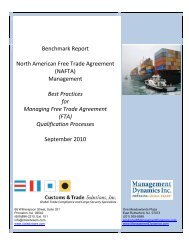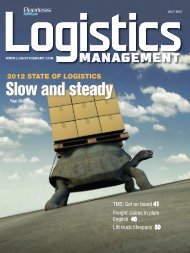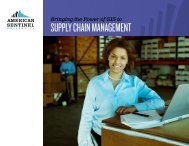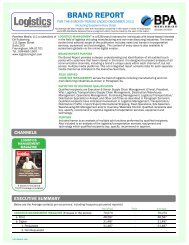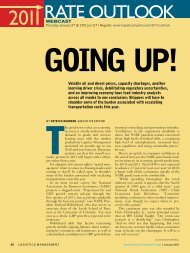Logistics Management - October 2011
Logistics Management - October 2011
Logistics Management - October 2011
Create successful ePaper yourself
Turn your PDF publications into a flip-book with our unique Google optimized e-Paper software.
Special Report: Top 30 Ocean CarriersA special supplement to logistics managementGraphic captionAsset-based carriers face new competitionThere’s an old joke still circulatingin the commercial maritimecommunity. It goes like this:“It’s easy to end up with a milliondollars by the time you retire from thisindustry. But first you have to invest10 million.”This is not necessarily the case fornon-asset-based middlemen, however.The Federal Maritime Commissionhad lifted the rate-tariff publicationrequirements for Non-Vessel-OperatingCommon Carriers (NVOCCs) earlier thisyear, thereby reducing regulatory burdensand bringing cost savings and flexibilityto the ocean cargo marketplace.The Shipping Act gives the Commissionauthority to grant exemptionsfrom its requirements if doing so willnot result in substantial reduction incompetition or detriment to commerce.According to comments filedwith the Commission, this actioncould save each of these businessesup to $200,000 per year.The final rule establishes aninstrument called a negotiated ratearrangement. Licensed NVOCCs whoenter into negotiated rate arrangementswith their customers will beexempted from the requirement ofpublishing their rates in tariffs if theymeet the following conditions:• NVOCCs would continue to publishrules tariffs containing terms andconditions governing shipments.• NVOCCs would be required toprovide those rules to the public freeof charge.• Rates charged by NVOCCs mustbe agreed to and memorialized inwriting by the date cargo is receivedfor shipment.• NVOCCs must retain documentationof the agreed rate for a periodof five years, and must make thatdocumentation available promptly tothe Commission upon request.“After a year of work and manyyears of debate, the Commission hasprovided thousands of dollars peryear in cost savings to these criticalU.S. supply chain businesses and thehundreds of thousands of exportersand importers they serve,” says FMCChairman Richard A. Lidinsky, Jr.—Patrick Burnson,Executive Editorrialize, and that resulted in continueddescending rates on most trading lanes,”says BIMCO’s Peter Sand.Oversupply in the main routes is thereason behind the weak freight rates. Theidle fleet of container ships now stands at84 vessels, with a total cargo capacity ofjust 185,000 twenty-foot equivalent units(TEUs), the lowest level since November2008. At the peak in January 2010, 1.5million TEUs were idle.“Severe overcapacity is poison toany freight market, as rates continueto decline even though volumes aregrowing fast…but not enough,” saysSand. “Cascading remains a part of thegame. It gives little comfort that freightrates on minor intra-Asian routes have60S <strong>October</strong> <strong>2011</strong> • <strong>Logistics</strong> <strong>Management</strong>




